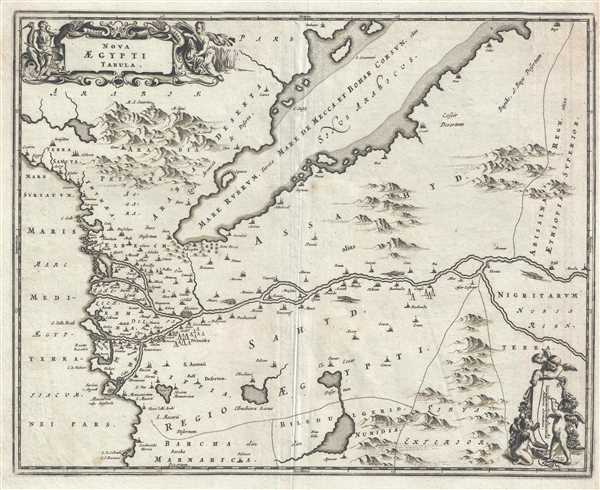This is a 1686 Olfert Dapper map of Egypt and the western Middle East. Oriented towards the east, the map depicts the region from the Mediterranean Sea to Abyssinia, or approximately modern-day Ethiopia, and from the Arabian Peninsula past the Red Sea and the Sinai Peninsula to Libya. A rather detailed depiction of the region, numerous cities are labeled, including Cairo and Alexandria in Egypt and Jerusalem and Hebron in the Holy Land (Terra Sancta, as it is labeled on the map). The vast majority of the cities are situated along the Nile, which appears to divide the map in two before branching out into the Nile Delta. This allowed the cities a secure source of water. The Pyramids at Giza are illustrated, although a great number more than are actually present in Giza. Mountains are illustrated in southern Egypt, Libya, and the Arabian Peninsula, one of which bears the label Mt. Sinai. Several large lakes are illustrated near the bottom border of the map, which may correspond to the handful of small oases which are still located in that general area. A decorative title cartouche is situated in the upper left corner, while a decorative cartouche, surrounded by cherubs, in the lower right corner bears the scale.
This map was produced by Olfert Dapper and published by in the French edition of Description of Africa entitled Description de L'Afrique and published in 1686.
Cartographer
Olfert Dapper (1636 - December 29, 1689) was a Dutch geographer, polyglot, and historian. Born in Amsterdam, he attended the University of Utrecht, where he was registered as a student in 1658. Two years later he began signing doctor medicinæ, but there in no evidence that he ever received any medical training or education. Dapper published a five-volume book about the history of Amsterdam entitled, Historische Beschrijving der Stadt Amsterdam and in 1665 published a Dutch translation from the Greek of the Histories of Herodotus. His best-known work, Naukeurige Beschrijvingen der Afrikaensche gewesten (Description of Africa), was published in 1668 and subsequently published in English by John Ogilby in 1670 and in French in 1686. Although Dapper never traveled to Africa, he took advantage of numerous reports from adventurers in order to compile this authoritative work over the course of three years. More by this mapmaker...
Source
Dapper, O., Description de L'Afrique, Contenant Les Noms, la Situation et les Confins de toutes ses Parties, leurs Rivieres, lerus Villes et leurs Habitations, leurs Plants et leurs Animaux; les Mœurs, les Coûtumes, la Langue, les Richesses, la Religion, et le Gouvernement de ses Peuples. Avec Des Cartes des Etats, des Provinces et des Villes, et des Figures en taille-douce, qui representent les habits et les principales Ceremonies des Habitans, les Plantes et les Animaux les moins connus (Amsterdam) 1686.
Description of Africa (Naukeurige Beschrijvinge der Afrikaensche Gewesten in the original archaic Dutch), first published in 1668, is an enthographic book which describes Africa. Written by the geographer Olmert Dapper and published by Jacob Van Meurs in two Dutch editions in 1668 and 1676, this work is considered to be one of the foundational works of African studies. Over the course of three years, Dapper consults numerous reports concerning the history and geography of the continent (as it was understood by 17th century Europeans) and travelogues. It is said that Dapper relied heavily on the records of the Dutch West India Company, although none of the original reports have been located by historians. In Description of Africa, per the Fondation Dapper, Dapper, 'far from passing judgement on the societies described and by avoiding ethnocentric connotations, was the first to apply an interdisciplinary approach, adroitly combining geography, economics, politics, medicine, and a study of culture.' Dapper did not write a 'work of exotic curiosities, but a work for posterity.' Description of Africa was published in English by John Ogilby in 1670 and a German translation appeared the following year. A French translation of the work was published in 1686.
Very good. Even overall toning. Blank on verso.


